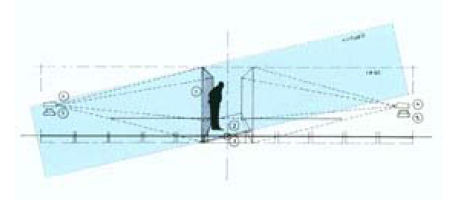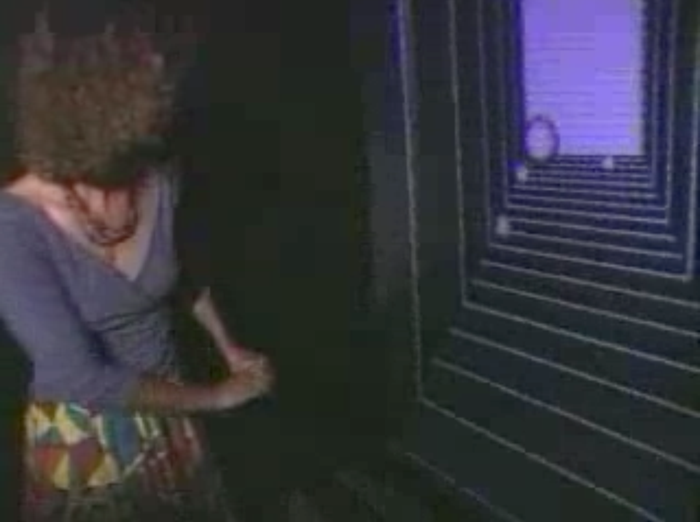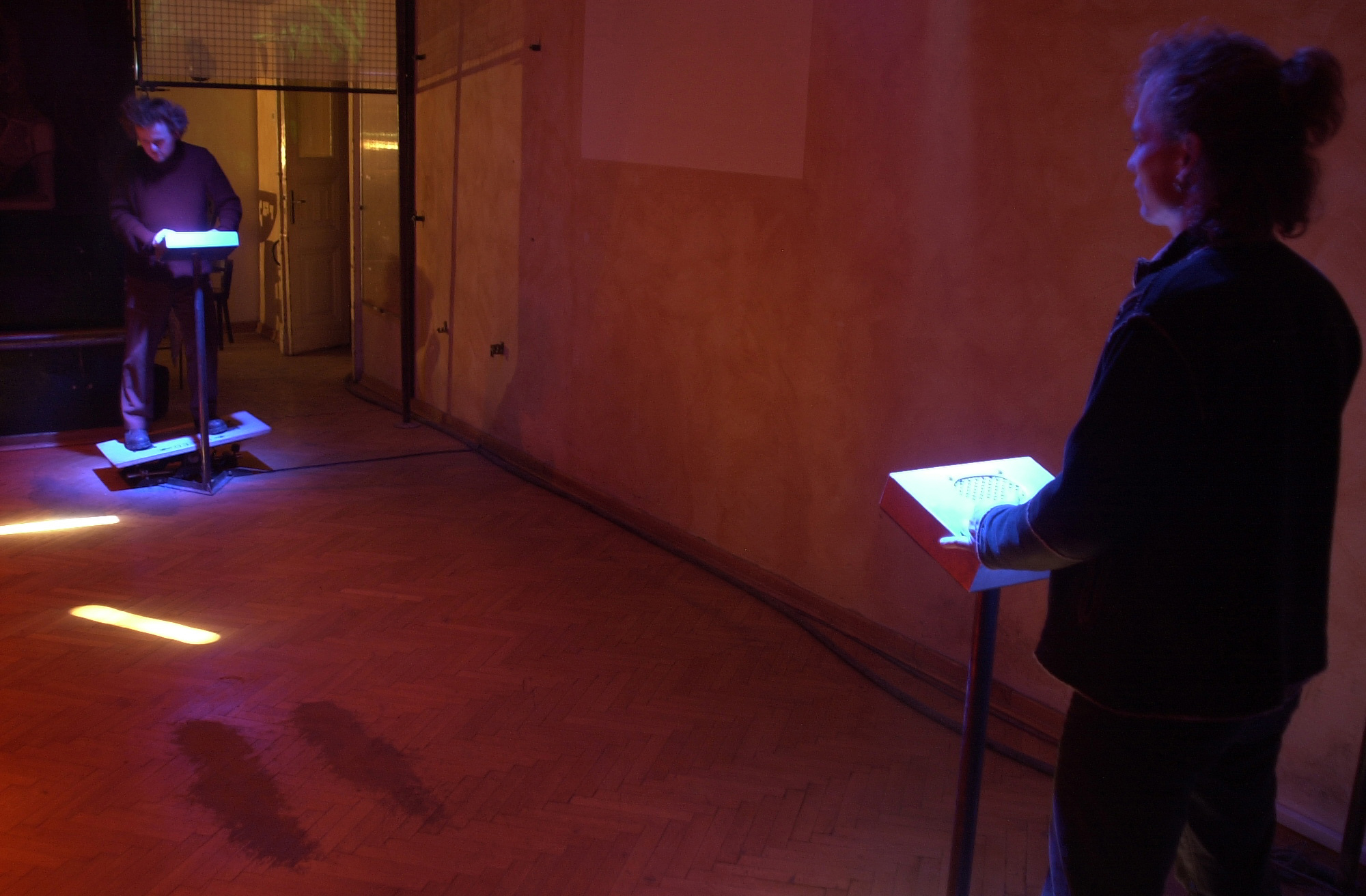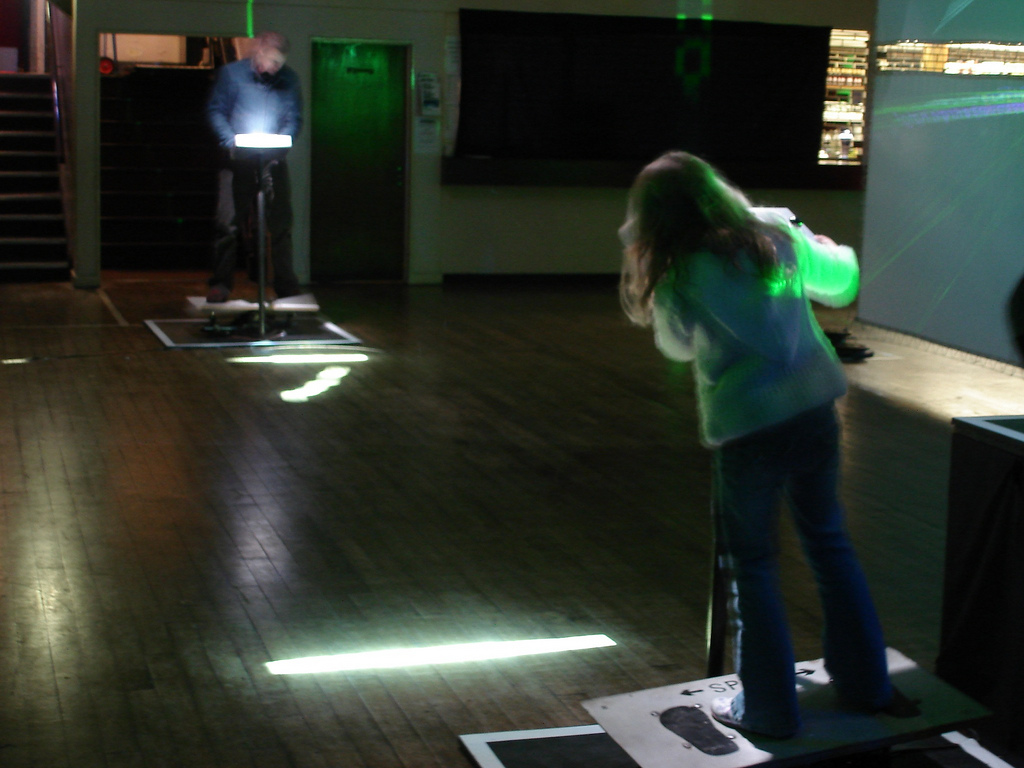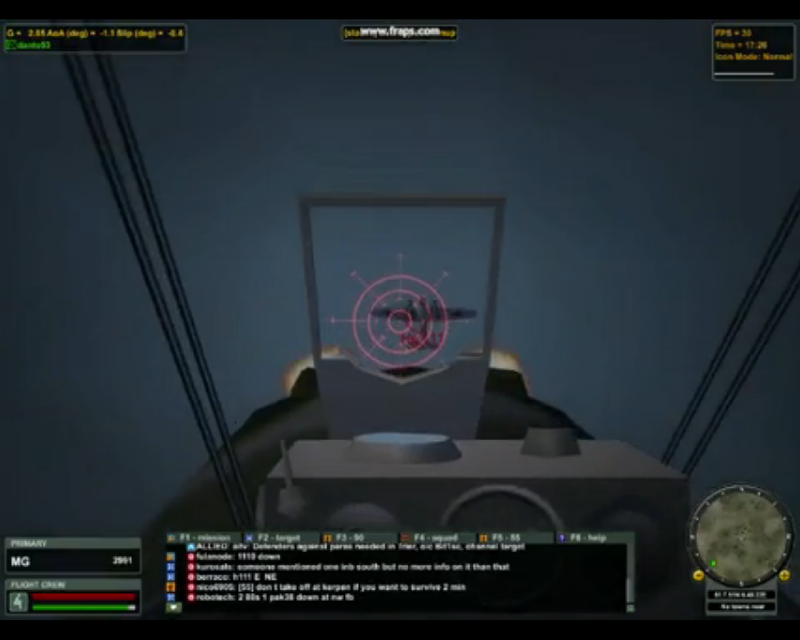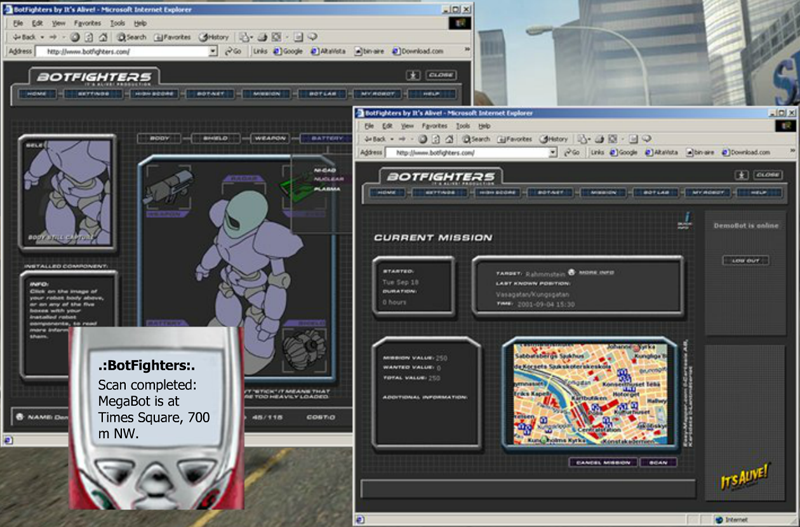IASLonline NetArt: Theory
Thomas Dreher
History of Computer Art
VII. Games
VII.2 Pervasive Games
- VII.2.1 Spatialization
- VII.2.2 Game-oriented World-Interface
- Illustrations Part XI: Pervasive Games: PPT / PDF
- Table of Contents
- Bibliography
- Previous Chapter
- Next Chapter
With the ego shooters "immersion" (see chap. VII.1.3.2, ann.76) became one of the important factors determining the history of computer games, as is shown in chapter VII.1.3: The players "involve" themselves actively ("involvement", see chap. VII.1.3.2, ann.76) into the game world with their actions and orientations between the input elements of a technical interface and the monitor presenting an immersing simulation. Players train their cognition of the relations between the monitor´s presentation of the game world and the possibilities offered by consoles, joysticks, mouses and/or keyboards to fulfill game affordances and to exploit the chances to win.
The exclusion of body parts not used for the input on technical interfaces and for the control of the screen´s output (technical interface) repeats the reduction of working processes to uses of eyes and hands. 1 After the Second World War the mechanically organised reduction of working processes to few involved body parts was developed further, and the reduction was continued by the digitalisation of organisational processes. Nevertheless the reactive installations of the first half of the nineties, as they were presented in chapter V, offer interfaces for a coordination of more parts of the body: The moving body is integrated into the installation no longer only with the coordinated movements of hands and eyes.
In Christian Möller´s "Space (im)Balance" (1992) 2 the observers move on a bridge-like platform. They change the bridge´s gradient in transferring their body weight. With their modifications of the bridge´s gradient observers activate the interface to two projections of a 3D animation. The projections on two adjacent long sides of the bridge present spheres moving in a simulated corridor. These movements depend on the bridge´s gradient. If observers want to maintain their upright posture then they have to react to changing gradients with balancing movements. Observers try to coordinate their balance adjustment with their efforts to influence the sphere´s movements between both projections. If observers change their position on the bridge to follow the sphere´s moves between the two projections then they modify the gradient of the bridge, too: With the indivisible relation between movements on the bridge and the image simulation the visitors´ possibilities to observe the sphere´s moves are restricted. If visitors modify the bridge´s gradient by motions to be able to follow the sphere´s movements from another point of view, then they change the sphere´s motion: In acting on the bridge visitors cause the following changes of the sphere because they initiate modifications of the projection with each correction of their body position made with the intention to ameliorate their angle of view.
Möller, Christian: Space (im)Balance, 1992, pavilion
with reactive installation in the interior space, Donaulände, Linz.
Top: vertical plan (Möller: Space 1992, p.158).
Bottom: The pavilion´s interior with one of the two projections
and an observer standing on the platform with a modifiable gradient.
Möller´s bridge is transformed in "Sonic Pong" by Time´s Up (1999) into an interface constituted by two little panels whose gradients can be modified with the feet. The 2D tennis game presentation of Atari´s classic "Pong" (1972, see chap. VII.1.2) is changed into a light projection of three signs – two beams for the two racquets and a circle for the ball – accompanied by sounds. The switching elements for the tonal control by hands are mounted on a board. The sound is emitted by a row of loudspeakers being placed between the two interfaces for inputs by hands and feet. Between the loudspeakers the sound follows the projection of the ball.
Time´s Up: Sonic Pong, 1999, reactive installation. Photos: Creative Commons.
Meanwhile players control the Pong projection they react to gravitational forces in their efforts to maintain their upright posture. Above the panels the boards are mounted on vertical bars and can be used by players as opportunities to hold themselves with their hands, to balance and to keep their upper bodies upright.
When players ask themselves if the tonal control was the goal of the developers, then they recognise the necessity to proceed with the game play for a continuation of the sound production using sampled sounds of old computer games. The sound production can be controlled by two rocker levers and a pressure switch. The produced sounds are of an interesting kind and can provoke an understanding of the modified Pong elements as an interface to the sound production. 3
The development of internet games is followed by a further phase of the spatialization of games. Many participants play against each other in Massively Multiplayer Online Games (MMOG) 4 on several servers storing variants in different languages. The online role game "Neverwinter Nights" (Massively Multiplayer Online Role Game 5, 1991-1997) offered in 1991 still to 200 participants, then in 1997 up to 500 participants a platform to play against each other alone or in teams with a game master. The 3D simulation represented the fantasy game world in the "third person overview". In June 2001 "World War II online" was presented as a "first person shooter" (see chap. VII.1.3.1) with characteristics of role playing games, as they were featured earlier in online games like "Ultima Online" (since 1997) from a "third person overview". 6
Battleground Europe: World War II online, 2001, MMOG.
Already in April 2001 – and thus two months before "World War II online" – It´s Alive releases the pervasive game "BotFighters" for mobile telephones presenting the locations of opponents on a 2D display. With its offer to combatants to choose their role in one of the camps (rebels against "Global nations") "BotFighters" anticipates the combination of shooters and the elements of role playing in "World War II online", but it reduces the 3D simulation on the mobile phone´s display to a diagrammatic 2D view of game fields with icons representing the avatars of players. In the science fiction game "BotFighters" the ego shooters´ perspective of players is substituted by the players moving in the real space.
It´s Alive: Botfighters 1, since April 2001, the screen of the mobile telephone.
The diagrammatic screen presentation is an element of the technical interface delivering informations that the players can coordinate with their orientation and actions in the world (world observation): The technical interface of the mobile phone (interface 2) and the world observation (interface 1) are mediated with each other by the players in the coordination of their `game moves´ (interface 3, see chap. VII.2.2). The coordination of movements in the real space and the virtual game world presupposes the player´s parallel self-orientation in the real world and the virtual combat zone: Thereby the mobile phone is simultaneously a scoreboard and the virtual part of the battlefield. For the game system only specific aspects of the orientation and motion in the real space are relevant, but nevertheless the player has to mobilise all capabilities for orientations and body coordinations to organize his movements in the real space.
It´s Alive: Botfighters 1, since April 2001, pervasive game, illustrations from the web site and the screen of the mobile telephone.
The localisation of players in cells uses mobile telephony´s cell-ID positioning technology. If opponents are located in the same mobile cell, then the game system informs them via SMS. At each day or night time a player can start a fight by ringing the combatant´s mobile phone. In the fights between rebels and "Global Nations" a player can try to enhance his account on the side chosen.
The account and the score-dependent hierarchy of the players are shown on the "BotFighter´s" website. 7 Players can also ameliorate the equipment of their avatars on the site of the commercial game. 8
The mobile screen with a 2D data visualisation presents to players the informations necessary for their coordinations of actions in the real space. More informations or even a virtual world worked out as a 3D animation 9 may be disturbing for the players´ efforts to coordinate their game moves in the urban traffic: Meanwhile moves at the consoles of computer games are coordinated by players "immersed" in virtual spaces and thus "involved" in 3D game worlds, the players of pervasive games use informations delivered by the screens of mobile gadgets to orientate themselves in the real space in a game-oriented functional way for the coordination of their strategies and moves. But the transfer of the navigation in simulated spaces back to the real spaces doesn´t cause a return of the self-orientation to strategies in street games. 10
In the course of the development of pervasive games after "BotFighters" the adaptation of computer games´ characteristics was at first deepened 11, until the developers overcame such dependencies.
At the pilot test of "Frequency 1550" (2/7-9/2005) eleven and twelve-year-old pupils of the course IVKO (Individueel Voorgezet Kunstzinnig Onderwijs) by Amsterdam´s Montessori Scholengemeenschap (association of Montessori schools) form six teams, each with four participants. Two players of a team stay in the head quarter at De Waag (the former city gate Sint Antoniespoort, 1488). The two other team members take over the role of pilgrims wandering in 1550 as penitents to the Hostie van het Mirakel in Amsterdam.
Waag Society: Frequency 1550, February 2005, pervasive game, pilot test.
In 15th November 1345 a sick man received a host before he dies. This host was found in the residues of his estate after it burnt to cinders. The place of this miracle became a destination of pilgrimages and led to the edification of a chapel as well as to a procession repeated annually. After the conversion of Amsterdam to the protestantism in 1578 the procession was continued. Since 1871 catholics organised the procession as a quiet walk, and the participants don´t carry any religious attributes.
In their role as penitents the participants pursue the goal to refind the (in the game) vanished host and to build a cloister. Only as citizens of Amsterdam they can receive a building permission. With the points received in accomplishing the tasks the players approach their goal to be recognised as citizens of Amsterdam.
A city map of the 16th century (from the collection of the Gemeentearchief Amsterdam) is divided in game sectors. The teams are assigned to specific sectors. Each team is equipped with two mobile phones: A mobile phone Nokia 6600 GPRS presents the city map of Amsterdam on its screen. The videostreams containing informations on the tasks of the game – a user manual and questions – are sent via UMTS and presented to each team on a second mobile, a Sony Ericsson Z 1010. In the urban space the teams get the instruction via GPRS on the first mobile phone to receive their next tasks via UMTS on their second mobile phone.
The street players carry GPS receivers. They are connected wireless by bluetooth to the GPRS mobile telephones being used to send the data to the game server. After the data are processed by the game server then they are sent to the GPRS mobile phones of the street players. On their screens the GPS localisation is presented on the city map of Amsterdam made in the 16th century.
In the head quarter a laptop presents the locations of all participants. The participants stationed at the head quarter can follow the paths of the teams on an actualised city map(in Flash) and they can switch to the map of the Gemeentearchief. While the participants of a team act in Amsterdam´s streets they compare the old city map on the screen of their GPRS mobile phone with the actual states of the urban environment. Especially the filled channels as well as the demolished and new bridges pose problems to the players´ efforts to orientate themselves in the actual city with a map of the 16th century.
The players located in the head quarter can help the other members of their team when questions concerning the current course of a street arise, and they can try to help to solve tasks as fast as possible (via input to search systems on the web). From the outdoor spaces the players send photos and films of solved tasks as e-mails with attachments via UMTS to the head quarter.
For the duration of 10 minutes competitors can deactivate with "GPS-boobytraps" the localisation being integrated into the game system via the GPRS mobile telephones. In these cases the view of the map remains intact. If the deactivated localisation can´t prohibit the participants of a team to arrive at a specific location before the end of the blocking period, than this period ends earlier.
The game´s pilot test had a duration of two days. In De Waag a third day was used to examine if the players memorised the informations they received on the history of Amsterdam in the first two days. It is told that the result of the test exceeded the expectations. 12
The test offered players to learn how the history of religions influenced the city as a growing field of forces integrating different structures (religions, urban planning, traffic, and others).
In the pervasive games described below changes in the states of the players´ moving bodies deliver the input to the carried mobile equipment. This equipment records dates and then processes or transports them in networks to servers. The screens of the mobile gadgets indicate to players if their movements remain within the programmed limits or if they transgress them.
Players coordinate the technically implemented part of the game´s rules with the non-implemented parts. To follow their game strategy and to fulfill the tasks the players try to accomodate their body movements to the informations indicated on the screens of the mobile equipment. In urban spaces the players have to care for their self coordination in traffic situations affording attentions not seldom simultaneously in times when the screens of the mobile equipments require this attention, too. The impossible simultaneous direction of the attention to the screens and the urban traffic has to be transformed into a sequentially structured observation, often under time pressure.
In "´Ere by Dragons" (2005) 13 the player´s attention is directed to his pulse because the mobile equipment reacts to it and switches itself off after two minutes lasting heart rates being either too high or too low.
Participants are equipped with PDAs (Personal Digital Assistants by Hewlett Packard : HPiPAQ), GPS receivers and a heart rate monitor (measures heart rates per minute). Two electrocardiograms (ECG contacts) of an ECG monitor are attached to a belt. They are strapped around the waist. A light weight sensor bus (Science Scope Sensor Slave) coordinates the connection of the two input systems GPS and ECG with the PDA. The ECG monitor (by Science Scope) is connected wirelessly with the sensor bus.
Active Ingredient/Lansdown Centre for Electronic Arts und London Institute for Sport and Exercise, Middlesex University, London/Mixed Reality Laboratory, Nottingham Trent University: ´Ere be Dragons, project, Nottingham, Februar und Dezember 2005/Singapore, November 2005/Berlin, October 2006.
A flash program reacts to the heart rate measured by the ECG in constructing isometric views of vegetative worlds. They are presented on the screen of the PDA to the players. The views coordinate specific motifs of landscapes with specific locations: If a player repasses the same location then the screen presents the same landscape motif.
The heart rate being adequate for each player and his age has to be ascertained before the game starts. The technical equipment is tuned to each player´s optimal heart rate. As long as a player sustains his optimal heart rate the screen of the PDA shows a landscape with grasses, trees and flowers. At a low rate the screen shows a desert, meanwhile a high rate is indicated by the presentation of an impermeable forest. When the player leaves the optimal heart rate, then a warning and, after two minutes, the deactivation follows. If players have to care about the traffic and are disabled to observe the screen, then audio signals facilitate the control of the pulse. A "client-server system" delivers the informations needed on the locations of other players.
The game intended for the activation of the body and as a means against obesity follows the concept of the "open play": "...it is up to the player to decide how they want to play." 14
The equipment of Jonas Hansen´s (former: Jonas Hielscher) game "Wanderer" (2005) 15 reacts to the player´s speed. The players have to react to instructions like "too fast, go slower" or "too slow, go faster".
A player walks with laptop, GPS receiver and headphone. GPS localisations deliver the basic input for the indication of a player´s speed. A beat of bleeps makes it easier to players to accomodate their speed (walking pace: 3-4 km/h). Obstacles have to be circumvented fast. Players increase their point account by following the instructions for direction changes (f.e. "Turn left now"), as they are generated by the game system´s chance operations, and by circumventions of obstacles lasting only a few seconds. Skilled reactions to game affordances and movements circumventing obstacles in the real space are rewarded in "´Ere by Dragons" and "Wanderer".
Hansen, Jonas: Wanderer, September 2005, pervasive game.
The development from games in exhibition spaces to games in urban spaces evolved from "Sonic Pong´s" spatialization of "Pong" to "BotFighters´" transfer of a MMORPG into the real space. Meanwhile in "BotFighters" and in "Frequency 1550" the game play is determined by two levels (the urban space and the game system) with affordances to the players to coordinate these levels with each other, in "´Ere by Dragons" and "Wanderer" the players integrate the states and actions of their bodies into their game strategies mediating between the urban space and the technical equipment.
A player´s reactions to situations in the urban traffic by a too much reduced or accelerated walking tempo and by increased heart rates are registered by the technical equipment. The registrations of his reactions cause in turn the player to correct his further movements: If a player integrates his body into the control of game moves in using the criteria indicated by the technical interface, then he integrates changes of his body in the same manner as he does it with other changing conditions of the environment. The player acts in this way as a controller of the organization of game moves (game-oriented world-interface, interface 3), but nevertheless in his organisation of further game moves he has another impact on conditions of his body as he has it on his adaptation to traffic conditions and other obstacles (internal environment/external environment). The part of the mobile equipment sustaining recursions of body states and actions to the game-oriented interface (interface 3) can be integrated into the body coordination like an artificial limb. The mediation between the body coordination for movements and orientations in the real space (world interface, interface 1) on the one hand, and the body coordination for the input to the mobile equipment (technical interface, interface 2) on the other hand, is realised by the coordination of the adaptable action schemes and plans (the cognitive body coordination) with measurable body effects (the biologic state). Players fulfill a two-fold reorientation concerning changing conditions of the environmental conditions and the changing informations about their own body: The game-oriented world observation (interface 3) is forced to mediate permanently in processes of reorientations between the self localisation by orientations within an environment (interface 1) on the one hand, and, on the other hand, the game´s rules and the affordances of the technical equipment (interface 2).
When players develop strategies for pervasive games then they take into consideration their body coordination in the real space as well as their handling of the technology and their use of the rules to play: The `interface 1´ is constituted by the interface of the observer to the world, and the `interface 2´ by the relation between the technical equipment and the rules to play (as they are not always technically implemented). The `interface 3´ consists of the players´ efforts to develop strategies coordinating their orientation in an environment including the traffic conditions (world-interface, interface 1) with the game´s affordances (interface 2).
The `world-interface´ or `interface 1´ is the interface between the inner and outside world, between cognition, proprioception and sensomotor functions on the one hand and, on the other hand, fields of action in changing environmental conditions.
Observers coordinate their movements in an environment and constitute their conceptions of the environmental conditions in collecting experiences by walking around: The observer acts within the world he is observing (world-internal observer). 16 The observer operations of body movements within the world are fed back to the observing operations coordinating the actions. 17 The observing operations are cognitive in the sense of knowledge, interest and attention as well as neurobiologic in the sense of a pre-reflective body coordination as it is presupposed, for example, by walking: Not each single step has to be coordinated, but only the direction and the speed. If wider brain areas are damaged then the trial to substitute the cancelled pre-reflective body coordination by intact brain areas causes a conscious and exclusively visually organized coordination. This requires a high concentration to be able to organise simple movements and excludes a body coordination after dark. 18 In activating the nerves being sensitive to audible, tactile and visual stimuli the body supplies input from the external environment and transfers these informations via the nerves to the brain areas being able to process these data in specific ways. In the brain environmental dates are integrated into the world observation in constructing "stimulation patterns", "schemes" and "turning markers". 19 Changings in these constructions cause modifications in the ways to control the body coordination for further movements in the world. The recursions of a body´s movements being made to collect new informations on the environment/world to the formation of world conceptions constitute the `interface 1´ respectively the interface of an observer to the world.
The `interface 2´ or `game-interface´ is constituted by the game rules that can be partially or fully implemented as parts of the technical game system. In games with technical systems implementing all rules players acting without knowledges of the game´s rules can use reactions of the game system to recognise if they follow or act contrary to these rules. Also in games integrating environmental factors only selectively, players make recourses to their `world-interface´ in its full extent for being able to supply the game system with the required dates obtainable by actions in the environment: For players it is impossible to act in real spaces if they did not develop their world observation, and, with it, their capabilities for self orientations and for the navigation of actions (interface 1). Strategies for the game play are results of plans for reactions to events in urban spaces under the conditions of the game. In game moves the strategies are executed under the conditions found in the environment (f.e. the traffic). 20
A walking player can keep his attention focused on a screen only for a short time, because he needs for walking straight ahead repeated visual checks of his own body and its relation to the environment 21: The design of pervasive games should take into account the body coordination and the ways it relates proprioception and outer perception.
The `interface 3´ or the `game-oriented world-interface´ consists of strategies developed by players for expected environmental conditions to realise chances to win via adequate moves. In ways to (sign-) act ("Spiel(zeichen)handeln" 22) between the signs of the game and the urban space the players develop a game-oriented world observation in intermediating `interface 1´ and `interface 2´. With Charles Sanders Peirce these mediations can be understood as mediations of "a first and second" in a "third":
Third is the conception of mediation, whereby a first and a second are brought into relation. 23
Pervasive games provoke players to relate `interface 1´ and `interface 2´ with each other in `interface 3´ by "embeddings, functionalizations, reductions, hierarchisations, recursions and determinations". 24
Dr. Thomas Dreher
Schwanthalerstr. 158
D-80339 München
Germany.
Homepage with numerous articles
on art history since the sixties, a. o. on Concept Art and Intermedia
Art.
Copyright © (as defined in Creative
Commons Attribution-NoDerivs-NonCommercial 1.0) by the author, December
2012 (German version)/ May 2014 (English version).
This work may be copied in noncommercial contexts if proper credit is
given to the author and IASL online.
For other permission, please contact IASL
online.
Do you want to send us your opinion or a tip? Then send us an e-mail.
Annotations
1 On the "body-hand-builder model" ("Kopf-Hand-Baumeistermodell") of modern times: Neusüß: Kopfgeburten 1985, p.63-73,105s.,119,131ss.,155. (review by Mies: Köpfe 1985; Schönbucher/Seitz: Neusüss 1985). back
2 Ars Electronica 92, Linz, Donaulände, 1992. In: Möller: Architektur 1994, p.31ss.; Möller: Space 1992. back
3 Time´s Up: Sonic 2006. back
4 Kücklich: Worlds 2009. back
5 Massively Multiplayer Online Role Game (MMORPG): Oliver: Eye 2002.
Neverwinter Nights: Medar: Neverwinter undated. back
6 Wikipedia: Ultima 2012. back
7 Respectively they were shown on the now-unavailable site of the game. back
8 Dreher: Games 2008, chap. Examples 1: Games with Virtual Spaces; Dreher: Sammeltipp 2, Teil 1 2005-2008 . back
9 Cf. Neitzel: Point 2007. back
10 Cf. the "New Games Movement" of the seventies and its aim to use games "as the vehicle for change" and to direct the players´ attention away from the competition to the cooperative play actions. Lit.: Flanagan: Play 2009, p.183s.; Fluegelman: Games 1976; Pearce/Fullerton/Fron/Morie: Play 2007, chap. 2; Salen/Zimmerman: Rules 2004, p.528s.; Turner: Games 2006. back
11 See the adaptations of PacMan using new technologies: Mixed Reality Lab: Human Pacman, Singapur, 2003-2004 (Dreher: Sammeltipp 2, Teil 1 2005-2008); New York University´s Interactive Telecommunications Programme: Pac Manhattan, New York, April 2004 (Dreher: Sammeltipp 2, Teil 2 2005-2008); InfoLab21, Department of Communication Systems, Lancaster University: Pac-Lan, Bailrigg/Lancaster, Dezember 2005-Februar 2006 (Dreher: Sammeltipp 2, Teil 3 2005-2008). back
12 A server connected via internet was used as the center of all dates. This server was programmed with KeyWorx, a software platform developed by the Waag Society in Amsterdam. The software was open to use it free of charges in non-commercial projects if the developing group was named (Triple license Mozilla Public License/ GNU GPL/ Creative Commons 1.0 Niederlande). Lit.: Dreher: Sammeltipp 2, Teil 2 2005-2008. back
13 By Active Ingredient/Lansdown Centre for Electronic Arts and London Institute for Sport and Exercise, Middlesex University, London/Mixed Reality Laboratory, Nottingham Trent University, Nottingham. Lit.: Dreher: Sammeltipp 2, Teil 2 2005-2008. back
14 Cooke/Davis/Jacobs/Moar/Riddoch/Watkins: Ere 2006, p.159s. back
15 Dreher: Sammeltipp 2, Teil 3 2005-2008. back
16 The "world-internal observer" being able to gain knowledge about the world only relative to his observer position: Dreher: Games 2008, chap. Endophysics: The World as an Interface and chap. World-Interface (Interface 1). back
17 "Observing/observer operations"/ "Beobachtungs-/Beobachteroperationen": Dreher: Performance 2001, p.20ss. back
18 Dreher: Games 2008, chap. Game-oriented World-Interface (Interface 3) with ann.42,43; Gallagher: Body 2005, esp. p.43ss.,74. back
19 Dreher: Games 2008, ann.34-36. back
20 Dreher: Games 2008, chap. From the Game to the Gamer´s Move. back
21 Gallagher: Body 2005, p.76: "...there is cortical integration of information concerning self-motion, spatial orientation, and visuomotor functions." back
22 "Sign-acting in games"/"Sprach(zeichen)handeln": Dreher: Games 2008, chap. World-Interface (Interface 1) with ann.40. back
23 Peirce: Architecture 1891, p.175. back
24 Dreher: Games 2008, chap. Types of Mediation of (Levels of) Interfaces (with examples and analyses). back
[ Table of Contents | Bibliography | Next Chapter ]
[ Top | Index NetArt | NetArt Theory | Home ]
